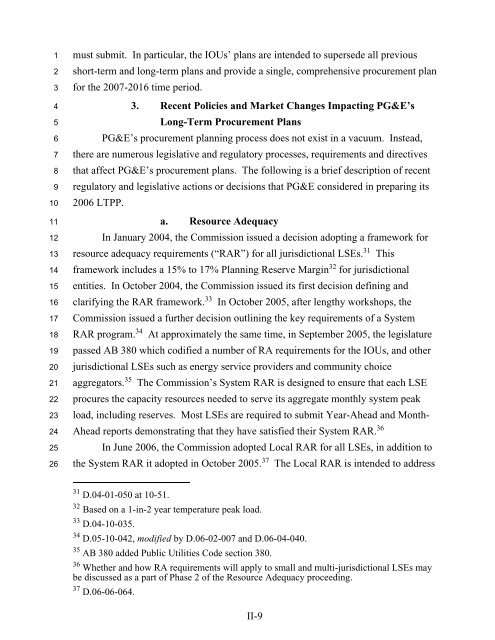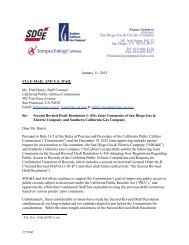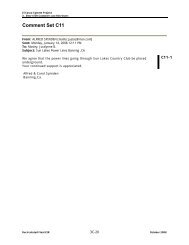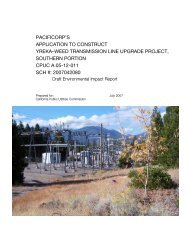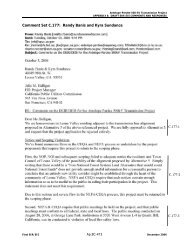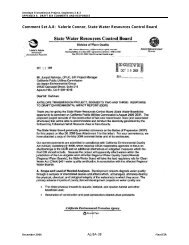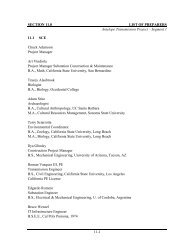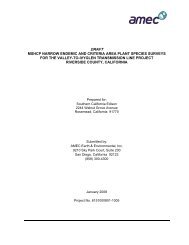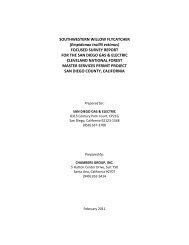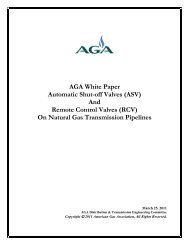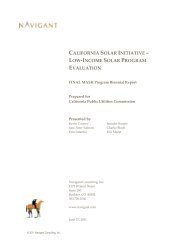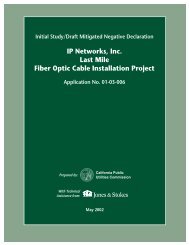Volume I. Part I - California Public Utilities Commission
Volume I. Part I - California Public Utilities Commission
Volume I. Part I - California Public Utilities Commission
Create successful ePaper yourself
Turn your PDF publications into a flip-book with our unique Google optimized e-Paper software.
1<br />
2<br />
3<br />
4<br />
5<br />
6<br />
7<br />
8<br />
9<br />
10<br />
11<br />
12<br />
13<br />
14<br />
15<br />
16<br />
17<br />
18<br />
19<br />
20<br />
21<br />
22<br />
23<br />
24<br />
25<br />
26<br />
must submit. In particular, the IOUs’ plans are intended to supersede all previous<br />
short-term and long-term plans and provide a single, comprehensive procurement plan<br />
for the 2007-2016 time period.<br />
3. Recent Policies and Market Changes Impacting PG&E’s<br />
Long-Term Procurement Plans<br />
PG&E’s procurement planning process does not exist in a vacuum. Instead,<br />
there are numerous legislative and regulatory processes, requirements and directives<br />
that affect PG&E’s procurement plans. The following is a brief description of recent<br />
regulatory and legislative actions or decisions that PG&E considered in preparing its<br />
2006 LTPP.<br />
a. Resource Adequacy<br />
In January 2004, the <strong>Commission</strong> issued a decision adopting a framework for<br />
resource adequacy requirements (“RAR”) for all jurisdictional LSEs. 31 This<br />
framework includes a 15% to 17% Planning Reserve Margin 32 for jurisdictional<br />
entities. In October 2004, the <strong>Commission</strong> issued its first decision defining and<br />
clarifying the RAR framework. 33 In October 2005, after lengthy workshops, the<br />
<strong>Commission</strong> issued a further decision outlining the key requirements of a System<br />
RAR program. 34 At approximately the same time, in September 2005, the legislature<br />
passed AB 380 which codified a number of RA requirements for the IOUs, and other<br />
jurisdictional LSEs such as energy service providers and community choice<br />
aggregators. 35 The <strong>Commission</strong>’s System RAR is designed to ensure that each LSE<br />
procures the capacity resources needed to serve its aggregate monthly system peak<br />
load, including reserves. Most LSEs are required to submit Year-Ahead and Month-<br />
Ahead reports demonstrating that they have satisfied their System RAR. 36<br />
In June 2006, the <strong>Commission</strong> adopted Local RAR for all LSEs, in addition to<br />
the System RAR it adopted in October 2005. 37 The Local RAR is intended to address<br />
31 D.04-01-050 at 10-51.<br />
32 Based on a 1-in-2 year temperature peak load.<br />
33 D.04-10-035.<br />
34 D.05-10-042, modified by D.06-02-007 and D.06-04-040.<br />
35<br />
AB 380 added <strong>Public</strong> <strong>Utilities</strong> Code section 380.<br />
36<br />
Whether and how RA requirements will apply to small and multi-jurisdictional LSEs may<br />
be discussed as a part of Phase 2 of the Resource Adequacy proceeding.<br />
37<br />
D.06-06-064.<br />
II-9


